
Concept explainers
Interpretation: The resonance structure of the
Concept Introduction:
- Sometimes the chemical bonding of a molecule cannot be represented using a single Lewis structure. In these cases, the chemical bonding are described by delocalization of electrons and is known as resonance.
- All the possible resonance structures are imaginary whereas the resonance hybrid is real.
- These structures will differ only in the arrangement of the electrons not in the relative position of the atomic nuclei.
To find: The resonance structure of
Answer to Problem 6.62QP
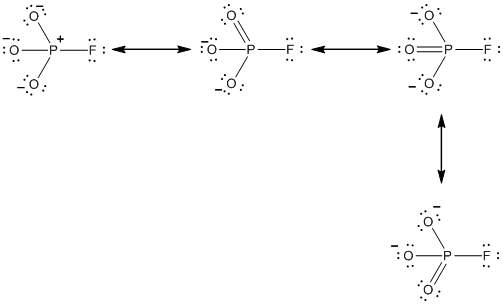
Explanation of Solution
Resonance structure of
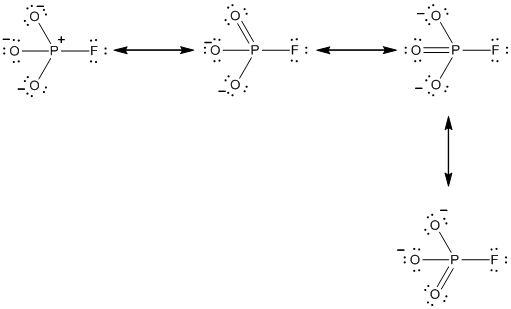
In the case of
The resonance structures of the
Interpretation: The formal charges of the
Concept Introduction
- A formal charge (FC) is the charge assigned to an atom in a molecule, irrespective of relative electronegativity by thinking that electrons in all
chemical bonds are shared equally among atoms. - This method is used to identify the most probable Lewis structures if more than one possibility exists for a compound.
- Formal charge of an atom can be determined by the given formula.
Answer to Problem 6.62QP
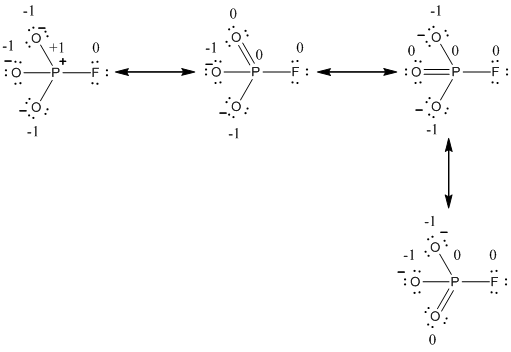
Explanation of Solution
The formal charge of the given resonance structure is given below.
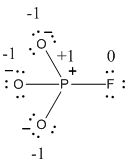
The formal charge of the given resonance structure is calculated,
- Phosphorous atom
Substituting these values to the equation,
- Oxygen atom (a)
Substituting these values to the equation,
- Oxygen atom (b)
Substituting these values to the equation,
- Oxygen atom (c)
Substituting these values to the equation,
- Fluorine atom
Substituting these values to the equation,
The formal charge of the given resonance structure is given below.
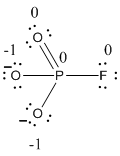
The formal charge of the given resonance structure is calculated,
- Phosphorous atom
Substituting these values to the equation,
- Oxygen atom (a)
Substituting these values to the equation,
- Oxygen atom (b)
Substituting these values to the equation,
- Oxygen atom (c)
Substituting these values to the equation,
- Fluorine atom
Substituting these values to the equation,
The formal charge of the given resonance structure is given below.

The formal charge of the given resonance structure is calculated,
- Phosphorous atom
Substituting these values to the equation,
- Oxygen atom (a)
Substituting these values to the equation,
- Oxygen atom (b)
Substituting these values to the equation,
- Oxygen atom (c)
Substituting these values to the equation,
- Fluorine atom
Substituting these values to the equation,
The formal charge of the given resonance structure is given below.
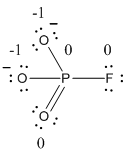
The formal charge of the given resonance structure is calculated,
- Phosphorous atom
Substituting these values to the equation,
- Oxygen atom (a)
Substituting these values to the equation,
- Oxygen atom (b)
Substituting these values to the equation,
- Oxygen atom (c)
Substituting these values to the equation,
- Fluorine atom
Substituting these values to the equation,
The formal charge of the
Want to see more full solutions like this?
Chapter 6 Solutions
CHEMISTRY:ATOMS FIRST (LL)>CUSTOM PKG.<
- Can I get helpp drawing my arrowsarrow_forwardWhich of the m/z values corresponds to the base peak in the mass spectrum shown? 100 80 A. 45 B. 44 C. 29 D. 15 Intensity 20 0 10 20 30 40 B- m/z -8 50 E. 30 Which of the m/z values correspond to the molecular ion for the compound shown? A. 18 B. 82 OH C. 100 D. 102 E. 103arrow_forwardCan someone help me with drawing my arrows.arrow_forward
- I'm having trouble with converting lewis diagrams into VSEPR diagrams. I currently have this example of C2BrCl3 which I want to turn into a lewis structure, but I'm not sure what steps I need to do in order to do so. I have the table written down, however, there's two central atoms so what would I do? There seems to be 4 electron domains on the carbon atom and no lone pairs so it would seem like this shape would be tetrahedral. Here's what I have now. Thanks!arrow_forwardWe discussed the solid phase resin using in peptide synthesis. Provide a mechanism, for its formation. DRAW THE MECHANISM.arrow_forwardPlease help. Every time I've asked an expert in the past, it's been wrong :(arrow_forward
 Chemistry: Principles and PracticeChemistryISBN:9780534420123Author:Daniel L. Reger, Scott R. Goode, David W. Ball, Edward MercerPublisher:Cengage Learning
Chemistry: Principles and PracticeChemistryISBN:9780534420123Author:Daniel L. Reger, Scott R. Goode, David W. Ball, Edward MercerPublisher:Cengage Learning Chemistry: Principles and ReactionsChemistryISBN:9781305079373Author:William L. Masterton, Cecile N. HurleyPublisher:Cengage Learning
Chemistry: Principles and ReactionsChemistryISBN:9781305079373Author:William L. Masterton, Cecile N. HurleyPublisher:Cengage Learning Chemistry: The Molecular ScienceChemistryISBN:9781285199047Author:John W. Moore, Conrad L. StanitskiPublisher:Cengage Learning
Chemistry: The Molecular ScienceChemistryISBN:9781285199047Author:John W. Moore, Conrad L. StanitskiPublisher:Cengage Learning


